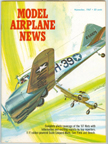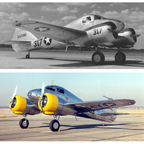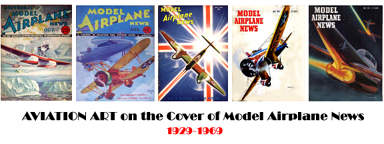November, 1967

Curtiss AT-9 "Jeep"
Model Airplane News Cover Art for November, 1967
by Jo Kotula
Click to Enlarge
The Curtiss-Wright AT-9 Jeep was a twin-engined advanced trainer aircraft used by the United States during World War II to bridge the gap between single-engine trainers and twin-engine combat aircraft. The AT-9 was of a low-wing cantilever monoplane configuration, had retractable landing gear and was powered by two radial engines.


Curtiss AT-9 "Jeep"
Click to Enlarge
Curtiss-Wright anticipated the requirement for this type of "high-performance" aircraft and designed the Curtiss-Wright CW-25, a twin-engine trainer, which possessed the takeoff and landing characteristics of a light bomber aircraft. Using the same basic design as the larger T-50 Bobcat, the new CW-25 was designed to be simulate the demands of multi-engine operations. The design featured a small layout, grouping two radial engines forward and using a retractable tail-wheel landing gear to achieve the performance necessary to meet the requirements of an advanced trainer. The single CW-25 prototype acquired for evaluation had a welded steel-tube fuselage structure with the wings, fuselage and tail unit fabric-covered.
The first prototype Model 25 flew in 1941 and the production version entered service as the AT-9 in 1942. Named the "Fledgling" by Curtiss-Wright, it commonly became known as the "Jeep" in the United States Army Air Forces (USAAF). The prototype CW-25 had a fabric-covered steel tube fuselage and fabric-covered wings and tail units, but production AT-9s were of stressed metal skin construction. The AT-9 was purposely designed to be less stable and proved be difficult to fly or land, which made it particularly suitable for teaching new pilots to cope with the demanding flight characteristics of a new generation of high-performance, multi-engine aircraft such as the B-26 Marauder and P-38 Lightning. A total of 491 AT-9s were built before production ended and a new production run of 300 of the generally similar AT-9A commenced. Because of its difficult flying characteristics the AT-9 was not offered for sale to civilians after the war, although many non-flying examples were given to ground schools for training purposes.
Click Here for more information about the Curtiss AT-9 "Jeep".

Click to go back and select another cover.
Counter for the Entire Site (not just this page..)
Home | About Lindy | Last Week's Reviews | Upcoming Events | 1940s Collecibles
The Guide - Establishments - Travel - Accessories
Music | Links | Photo Gallery | Extras | Contact